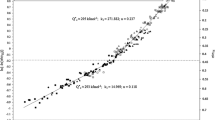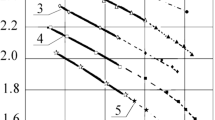The paper addresses the problem of compiling and updating the high-temperature creep rupture strength data for steels and alloys used in heat-and-power engineering, and various aspects of tackling the problem are discussed. Special attention is given to the necessity of processing the available creep rupture strength data by the base diagram method, the generalized and detailed representation of such data for the widest possible temperature–time ranges, and subsequent system analysis.


Similar content being viewed by others
References
V. V. Krivenyuk, Creep Rupture Strength Prediction for Refractory Metals and Alloys [in Russian], Naukova Dumka, Kiev (1990).
G. S. Pisarenko and V. V. Krivenyuk, “A new approach to creep rupture strength prediction for metals,” Dokl. AN SSSR, Mekhanika, 312, No. 3, 558–562 (1990).
V. V. Krivenyuk, “A method of prediction of creep rupture strength characteristics of heat-resistant and refractory materials,” in: Proc. Ist Symposium on Materials Creep, Bialystok (1983), pp. 325–332.
V. V. Krivenyuk, “Creep-rupture prediction for steels and alloys by parametric methods and the base diagram method. Part 1. Interpolation analysis of experimental data,” Strength Mater., 38, No. 5, 515–526 (2006).
R. R. Larson and J. Miller, “Time–temperature relationship for rupture creep stress,” Trans. ASME, 74, No. 5, 765–775 (1952).
S. S. Manson and A. M. Haferd, A Linear Time-Temperature Relation for Extrapolation of Creep and Stress Rupture Data, NASA TN 2890 (1953).
R. I. Orr, O. D. Sherby, and J. E. Dorn, “Correlation of rupture data for metals at elevated temperatures,” Trans. ASM, 46, 113–128 (1954).
V. V. Krivenyuk, “Long-term creep-rupture prediction for metallic materials,” Strength Mater., 35, No. 4, 403–412 (2003).
V. V. Krivenyuk, “Special correlations between short-time strength and creep rupture strength characteristics,” Metaloznav. Obrob. Metal., No. 1, 63–66 (2006).
É. V. Prikhod’ko, Effectiveness of Complex Alloying of Steels and Alloys [in Russian], Naukova Dumka, Kiev (1995).
Data Sheets on the Elevated-Temperature Properties of 1Cr–1Mo–0.25 V Steel, NRIM Creep Data Sheet, No. 9B (1990).
Data Sheets on the Elevated-Temperature Properties of 1Cr–1Mo–0.25 V Steel, NRIM Creep Data Sheet, No. 31B (1994).
L. Ya. Liberman and M. I. Peisikhis, Properties of Steels and Alloys Usedin Boiler and Turbine Manufacture [in Russian], Issue 16, TsKTI, Leningrad, Part 1 and 2 (1966), Part 3 (1967).
V. V. Krivenyuk, L. A. Zaslotskaya, and D. S. Avramenko, “Some features and potentialities of the generalized analysis of creep-rupture data for metallic materials,” Strength Mater., 32, No. 3, 225–233 (2000).
Data Sheets on the Elevated-Temperature Properties of 0.5Cr–0.5Mo Steel, NRIM Creep Data Sheets, No. 20B (1994.).
Author information
Authors and Affiliations
Additional information
Deceased.
Translated from Problemy Prochnosti, No. 4, pp. 20 – 32, July – August, 2012.
Rights and permissions
About this article
Cite this article
Krivenyuk, V.V., Avramenko, D.S., Uskov, E.I. et al. The problem of preparation of creep rupture strength data during the formulation of regulatory documents for metal-intensive power equipment. Strength Mater 44, 359–368 (2012). https://doi.org/10.1007/s11223-012-9389-y
Received:
Published:
Issue Date:
DOI: https://doi.org/10.1007/s11223-012-9389-y




